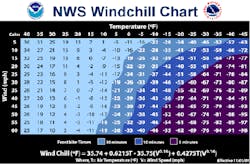Much of the country is gripped in a cold wave that has sent temperatures plummeting to as low as -40 F with the wind chill. We all can agree that temperatures that low are dangerous, but hypothermia, which kills 28,000 people each year, can occur in much higher temperatures, particularly when wind or water are involved.
When our body temperatures sink below 96ºF, we have hypothermia. Prolonged exposure to temperatures as warm as 60ºF, particularly in water, can trigger hypothermia if we aren't properly dressed.
Of the 28,000 people hypothermia kills yearly, most are seniors, according to the National Institute of Aging, but everyone needs to be careful. Some medicines, problems with circulation and certain illnesses may reduce our ability to resist hypothermia.
As we age, our bodies become less efficient at letting us know when we are too cold. In addition, older people tend not to shiver effectively, one of the ways the body warms itself up. Remember these tips to help prevent hypothermia:
- Dress in layers; wrap up well when going outside in the cold. Remember to wear gloves, a hat, a coat and warm, waterproof boots.
- When working outside, take frequent breaks in a warm area (building, truck). Work with a buddy, or work out a communication system so that if you do become incapacitated from the cold, you miss a check-in and others are alerted.
- Avoid breezes and drafts indoors.
- Eat nutritious food that provides you with energy. Your body will be working overtime to keep you warm. Eat hot foods and drink warm drinks several times during the day.
- If you have an elderly neighbor or family member who lives alone, check on him or her daily.
- Ask your doctor if any medicine you're taking increases your risk of hypothermia. Drugs that may cause a problem include barbiturates, benzodiazepines, chlorpromazine, reserpine and tricyclic antidepressants.
If a person’s temperature is 96ºF or less, he or she feels cold and sluggish or he or she is having trouble thinking clearly, get them to a doctor immediately or take them to the nearest emergency room. It's better to be overly cautious than to die of a disorder that doesn't have to be deadly.
If you are trying to help someone who may have hypothermia, first call an ambulance. Then lie close to the person and cover both of you with thick blankets. The hotter you get, the more warmth you can give the other person. Don't rub the person or handle him or her roughly.
In the workplace, have a policy regarding working in cold weather just as you do for the conditions that contribute to heat-related illness and death. The National Weather Service has provided a wind chill chart – much like the heat index chart – that provides an accurate, understandable, and useful formula for calculating the dangers from winter winds and freezing temperatures.
About the Author

Sandy Smith
Sandy Smith is the former content director of EHS Today, and is currently the EHSQ content & community lead at Intelex Technologies Inc. She has written about occupational safety and health and environmental issues since 1990.

